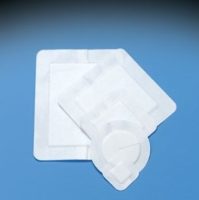Understanding Composite Wound Dressings
Composite wound dressings combine different types of dressings with several functions in one single dressing that can address different needs. They can be used as a primary and/or secondary dressing and feature an absorptive layer, and a strike-through barrier.
Composite Wound Dressings Are Versatile

These dressings are versatile and convenient offering options for both partial and full thickness wounds. Their water-proof nature makes them a popular choice for areas prone to moisture assault from incontinence. These versatile dressings provide a barrier to bacteria and other contaminants, while offering a simple “Band-Aid” type application and removal.
Composite dressings are dressings that combine the advantages of multiple layers, providing more than one function in wound care management. Each layer of dressing is physiologically distinct.
Most (But Not All) Composite Wound Dressings Have Three Layers
- The bottom layer is usually composed of a semi- or non-adherent material, which allows moisture to travel though to the next layer while preventing the dressing from sticking to the freshly granulating tissue of the wound bed.
- The middle layer is generally composed of an absorptive material, which pulls moisture away from the wound bed, keeping it moist but preventing maceration of the skin. It also helps to inhibit bacterial growth and assists in the process of autolytic debridement.
- The outermost layer protects the wound from bacterial invasion and allows air to circulate. The outer layer also prevents moisture from leaking through to the top layer of dressing, allowing for less frequent dressing changes.
Usually, composite wound dressings are comprised of multiple layers and incorporate a semi- or non-adherent pad that covers the wound. Composite dressings may also include an adhesive border of non-woven fabric tape or transparent film. They can function as either a primary or a secondary dressing on a wide variety of wounds and may be used with topical medications. Composite dressings come in a variety of shapes and sizes.
Learn More About Wound Management
If you are interested in learning more about wound dressings, consider achieving wound care certification. WoundEducators.com offers wound care certification courses that you can complete at your own pace, in the comfort of your own home. For more information view our wound care certification courses.
